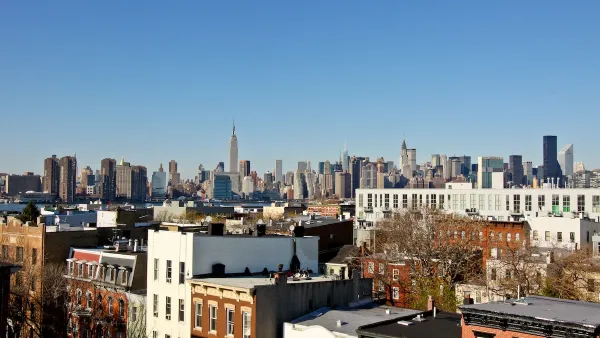A 298-unit, 18-story tower in Pacific Park Brooklyn opened its doors to new renters in various categories of affordability over five months ago. 27% remain empty in the higher income tiers, and unlike market-rate units, the asking rent won't drop.
Posts on vacant housing in Planetizen often deal with what to do with abundance of empty, blighted homes in shrinking Rust Belt cities like Cleveland. Vacant properties exist in New York City as well, and homeless advocates are pressuring the city to track them. But how can one explain vacancies in newly constructed, all-affordable buildings?
Case in point: 535 Carlton in what is now called Pacific Park Brooklyn, renamed from Atlantic Yards in 2014 by the joint development company, Greenland Forest City Partners "after the Chinese government-owned Greenland Group bought a 70% stake in 15 towers" from Forest City Ratner.
The building broke ground in December 2014. "Mayor Bill de Blasio pronounced the affordability criteria for the development '100% affordable,' and credits the development toward his goal of adding and preserving 200,000 affordable residential units in the next 10 years," notes the Planetizen post that lists the five income tiers eligible for prospective tenants.
Units were allotted through a city-housing lottery, reports Ginia Bellafante, Big City columnist for The New York Times on Nov. 17. No problem renting out the 25 percent of apartments to tenants who qualified for the "extremely low and "very low" income categories, based on average median income.
Half the apartments, though, were slated for middle-income occupants, and although the lottery received more than 93,000 applications, an inadequate number of qualified tenants in the highest income brackets has left 80 apartments empty.
I recall in my last apartment building, the landlord would lower the asking rent based on how long it remained on the market. That won't be the case in the "all-affordable" 535 Carlton though, explains Bellafante.
The way that these public-private partnerships are structured and underwritten, however, the revenue from more expensive units helps offset the rents of those apartments intended for lower-income tenants (some one-bedroom apartments at 535 Carlton, for example, cost as little as $589 a month). Developers can’t just lower the rents to accommodate demand and keep the projects financially viable.
The developer, Greenland Forest City Partners, is now advertising them via StreetEasy, social media and so on.
No word as to whether the property manager is offering "generous incentives, usually in the form of one, two, or even three months of free rent offered to those who sign leases for high-end apartments," as noted in an August 2016 post on the oversupply of luxury units in Brooklyn.
Additional reading on 535 Carlton:
- City Limits: "Atlantic Yards Developers Struggle to Find Tenants for Higher-Income Affordable Units" | November 3, 2017
- Curbed NY: "Pacific Park welcomes first residents to its all-affordable, COOKFOX-designed rental," Jun 12, 2017
FULL STORY: At $3,700 a Month, ‘Affordable’ Apartments Go Begging

Maui's Vacation Rental Debate Turns Ugly
Verbal attacks, misinformation campaigns and fistfights plague a high-stakes debate to convert thousands of vacation rentals into long-term housing.

Planetizen Federal Action Tracker
A weekly monitor of how Trump’s orders and actions are impacting planners and planning in America.

In Urban Planning, AI Prompting Could be the New Design Thinking
Creativity has long been key to great urban design. What if we see AI as our new creative partner?

King County Supportive Housing Program Offers Hope for Unhoused Residents
The county is taking a ‘Housing First’ approach that prioritizes getting people into housing, then offering wraparound supportive services.

Researchers Use AI to Get Clearer Picture of US Housing
Analysts are using artificial intelligence to supercharge their research by allowing them to comb through data faster. Though these AI tools can be error prone, they save time and housing researchers are optimistic about the future.

Making Shared Micromobility More Inclusive
Cities and shared mobility system operators can do more to include people with disabilities in planning and operations, per a new report.
Urban Design for Planners 1: Software Tools
This six-course series explores essential urban design concepts using open source software and equips planners with the tools they need to participate fully in the urban design process.
Planning for Universal Design
Learn the tools for implementing Universal Design in planning regulations.
Appalachian Highlands Housing Partners
Gallatin County Department of Planning & Community Development
Heyer Gruel & Associates PA
Mpact (founded as Rail~Volution)
City of Camden Redevelopment Agency
City of Astoria
City of Portland
City of Laramie




























